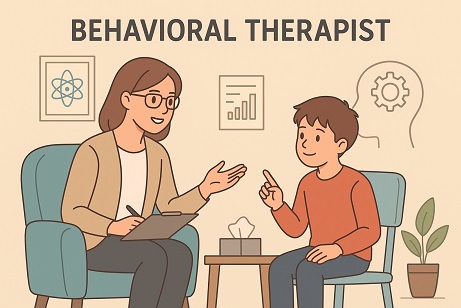Stories you may like
Behavioral Therapist
A behavioral therapist specializes in helping people understand and change their behaviors. They focus on identifying negative or unhelpful behaviors and work with individuals to replace them with healthier, more positive ones. This approach is commonly used to address issues like anxiety, depression, addiction, or behavioral problems in children. Behavioral therapy is based on the idea that behaviors can be learned and unlearned through specific techniques.
Behavioral therapists work with people of all ages and in different settings, including private practices, schools, clinics, and hospitals. They tailor their approaches to each individual, making the therapy a personalized way to address specific mental health or behavioral issues. The goal is to help clients improve their well-being by changing harmful behaviors and fostering healthier patterns.
Duties and Responsibilities
A behavioral therapist has several key responsibilities when working with clients to help them change unhelpful behaviors. Here are the main duties of a behavioral therapist:
- Assessing Clients: A behavioral therapist begins by evaluating a client’s behavior, emotions, and thoughts to understand the issues they are facing. This helps identify patterns of behavior that need to be addressed.
- Developing Treatment Plans: Based on the assessment, the therapist creates a personalized treatment plan that targets specific behaviors and issues. The plan often includes techniques like cognitive-behavioral therapy (CBT) or reinforcement strategies.
- Providing Therapy Sessions: The therapist works with clients regularly to implement the strategies in their treatment plan. These sessions can be one-on-one or group therapy, depending on the client's needs.
- Tracking Progress: The therapist monitors the client’s progress, adjusting the treatment plan as needed. They evaluate how well the client is responding to therapy and whether the behaviors are improving.
- Supporting Clients in Managing Challenges: Behavioral therapists provide support, helping clients develop coping skills and strategies for managing difficult emotions or situations.
Key skills for a Behavioral Therapist
Core Skills - Behavioral Assessment – Ability to observe, analyze, and evaluate client behavior to identify patterns and triggers.
- Intervention Planning – Designing structured behavior intervention plans (BIPs) tailored to client needs.
- Applied Behavior Analysis (ABA)– Expertise in ABA techniques, reinforcement strategies, and behavior modification methods.
- Crisis Management – Handling challenging or aggressive behaviors calmly and effectively.
- Therapeutic Techniques– Knowledge of cognitive-behavioral therapy (CBT), social skills training, and coping strategies.
Technical & Professional Skills - Data Collection & Analysis – Recording behavioral data, monitoring progress, and making data-driven decisions.
- Documentation & Reporting– Preparing detailed session notes, treatment progress reports, and compliance records.
- Knowledge of Disorders – Understanding conditions like autism spectrum disorder (ASD), ADHD, anxiety, and developmental disabilities.
- Collaboration – Working with parents, teachers, healthcare providers, and multidisciplinary teams.
- Ethics & Confidentiality – Adhering to professional guidelines and protecting client privacy.
Soft Skills - Communication – Clear, empathetic communication with clients and families.
- Patience & Empathy – Supporting clients through challenges with understanding and compassion.
- Problem-Solving – Adapting interventions to meet changing client needs.
- Adaptability – Flexibility to modify strategies depending on progress or setbacks.
- Motivational Skills – Encouraging clients to participate and stay engaged in therapy.
Workplace of a Behavioral Therapist
The workplace of a behavioral therapist can vary depending on the setting in which they work. Many behavioral therapists work in private practices, where they meet clients in a quiet, comfortable environment. In this setting, the therapist typically has a dedicated space where they can conduct one-on-one sessions and create a safe, confidential space for their clients to open up and work through their issues.
Behavioral therapists may also work in hospitals, mental health clinics, or rehabilitation centers. In these environments, they may work as part of a larger healthcare team, collaborating with doctors, nurses, and other therapists to help patients. The workplace in these settings is often more structured, with specific schedules for seeing clients and providing group therapy sessions for individuals with similar issues.
Some behavioral therapists work in schools or educational settings, helping children with behavioral issues or learning disabilities. In schools, they may work with students, teachers, and parents to develop strategies to improve student behavior and academic performance. The work environment in schools is typically more dynamic, as the therapist may be moving between classrooms, attending meetings, and interacting with various staff members to support the needs of students.
How to become a Behavioral Therapist
To become a behavioral therapist, there are several steps you need to follow, starting with the right education and continuing through gaining experience and obtaining necessary certifications.
- Earn a Relevant Degree: Typically, you will need at least a Bachelor's Degree in Psychology, Social Work, or a related field. This foundational education provides the necessary knowledge of human behavior and mental health.
- Pursue a Master’s Degree (Optional but Recommended): Although not always required, many behavioral therapists pursue a Master’s Degree in Counseling Psychology, Psychology, or Social Work. This advanced education allows for deeper expertise and better job opportunities.
- Gain Experience through Internships or Supervised Practice: Many programs require hands-on experience, where you work under the supervision of a licensed therapist. This practical experience is crucial for learning real-world techniques and skills.
- Obtain Licensure or Certification: Depending on the region, you may need to become licensed or certified to practice as a behavioral therapist. This usually involves passing an exam and meeting the requirements set by the licensing board.
- Continue Education and Training: Behavioral therapists often pursue additional certifications or attend workshops to stay updated on the latest techniques. This ongoing learning helps you provide the best care for your clients.
Types of Behavioral Therapy
When it comes to helping your child manage their behavior, understanding the different types of behavioral therapy can be incredibly useful. Each type has its unique approach and benefits, making it possible to tailor the therapy to your child’s specific needs. Here are some of the most commonly used types of behavioral therapy:
1. Applied Behavior Analysis (ABA)
Applied Behavior Analysis (ABA) is a highly structured approach that focuses on improving specific behaviors such as social skills, communication, and academics. It uses techniques like positive reinforcement to encourage desired behaviors and reduce undesirable ones. ABA is particularly effective for children with autism spectrum disorder (ASD).
2. Cognitive Behavioral Therapy (CBT)
Cognitive Behavioral Therapy (CBT) combines behavioral techniques with cognitive therapy to address the thoughts and feelings that influence behaviors. It helps children understand the connection between their thoughts, emotions, and actions. CBT is effective for treating a wide range of issues, including anxiety, depression, and ADHD.
3. Dialectical Behavioral Therapy (DBT)
Dialectical Behavioral Therapy (DBT) is a form of CBT that focuses on teaching children skills to manage their emotions, cope with stress, and improve relationships. It is especially useful for children who have intense emotional responses and struggle with interpersonal relationships. DBT combines individual therapy with group skills training sessions.
4. Exposure Therapy
Exposure Therapy is designed to help children overcome their fears and anxieties by gradually exposing them to the source of their fear in a controlled environment. This approach helps them build confidence and learn how to manage their anxiety. Exposure Therapy is often used to treat phobias, PTSD, and obsessive-compulsive disorder (OCD).









User's Comments
Farhanjani jani Reply
Rebuild strength after fractures and improve flexibility through guided physiotherapy recovery — click this site to begin your healing journey. chiropractic Care Vaughan
Farhanjani12 Reply
Train confidently with Online CNA classes Inland Empire CA supported by friendly instructors whenever you need help. Online CNA classes Inland Empire CA